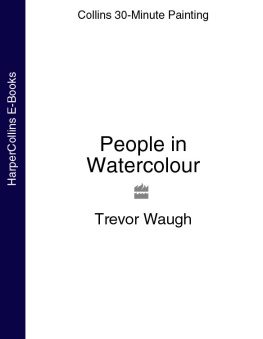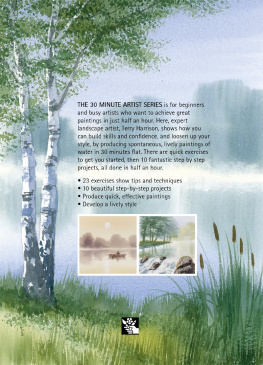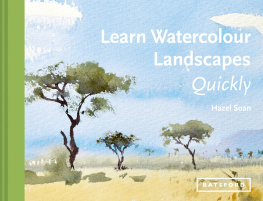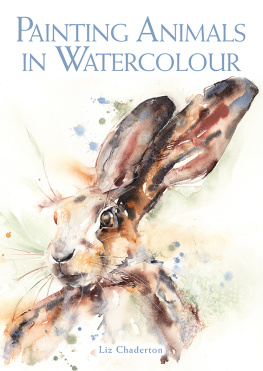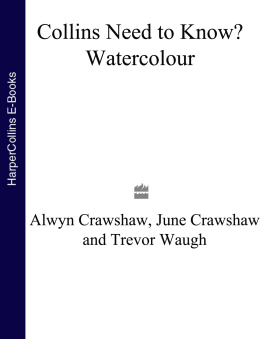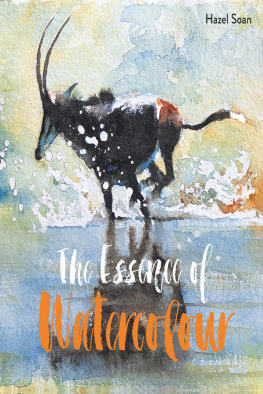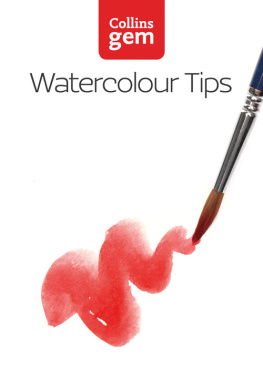
To Dorothy, my wife, for her support, advice and typing of the text, and to all my students over the years whose needs have helped me to determine the content of this book.
Introduction
Your watercolours can become your signature in paint.
Watercolour painting opens up a new world for the artist. It is an exciting medium, since the unexpected can happen when colours blend together to create wonderful effects. It is also famed for its luminosity, with the white of the paper showing through translucent washes. As well as traditional watercolours, acrylic paints can also be applied with watercolour techniques to give a similar effect, and you will find many examples of their use in this book.
Many people think they cant paint. Well, I say they can. I dont believe painting is a gift. Anyone can be taught to paint. However, whatever we hope to achieve in life, we have to work at it. The same goes for painting. Even if you never reach masterclass level, painting will change your life ask any artist. Yes, you will make mistakes; we all do. The secret is to understand what has gone wrong and to learn from your mistakes.
My aim in this book is to save you 20 years of learning by telling you about the techniques, tips and useful practices I have developed over decades. I shall show you how to paint a wide range of outdoor scenes, including mountains, lakes, trees, water, buildings, bridges and walls. In addition I shall be demonstrating how to bring atmosphere and mood to your paintings.
It is not my intention to impose a specific style of painting on you. With practice you will develop your own, and this will become your handwriting in paint, easily recognizable by others as your personal signature.
Learning to paint in watercolours is fun, and its easier than you think. I welcome this opportunity to show you how its done. Happy painting!



Materials & Equipment
Choose your materials carefully they do make a difference.
Introduction
A visit to an art store can be a confusing experience as so much is on offer. My preference is to use goodquality materials, and I advise you to do the same. Buying the best you can afford will work out cheaper in the long run and save you a great deal of frustration.
Paints
Most professional artists prefer tube colours because they are moist and more convenient for mixing large washes of colour. Pans of paint become very hard if left unused and release less colour.
The choice of colours is personal to the artist, but you wont go far wrong if you begin with my basic range. This comprises:
Skies
Alizarin Crimson
Cerulean Blue
Cobalt Blue
French Ultramarine
Indanthrene Blue
Paynes Grey
Winsor Red
Earth
Burnt Sienna
Burnt Umber
Cadmium Yellow Pale
Gold Ochre
Permanent Sap Green
Raw Sienna
Winsor Yellow
Rocks
Alizarin Crimson
Burnt Sienna
Burnt Umber
Paynes Grey
Raw Sienna
Trees
Alizarin Crimson
Burnt Sienna
Cadmium Yellow Pale
Cerulean Blue
French Ultramarine
Paynes Grey
Permanent Sap Green
Raw Sienna
Water
Alizarin Crimson
Burnt Umber
Cerulean Blue
French Ultramarine
Paynes Grey
Light
Cadmium Yellow Pale
Gold Ochre
Raw Sienna
White of the paper
Winsor Yellow
Atmosphere & mood
Alizarin Crimson
Burnt Umber
Cerulean Blue
French Ultramarine
Paynes Grey
Raw Sienna
Shadows
Alizarin Crimson
Burnt Umber
French Ultramarine
Raw Sienna
Brickwork
Burnt Sienna
Cobalt Blue
Raw Sienna
Vermilion
Stonework
Alizarin Crimson
Burnt Sienna
Cobalt Blue
Raw Sienna
Special applications
Gold Ochre
Purple Madder
Winsor Red
Winsor Yellow

Palette
All artists have their own way of painting. I prefer to use a large open palette. I simply draw my colours into the centre of the palette and mix them to my requirements. For large washes I premix colours in saucers. The palette includes a lid which provides more than ample space for mixing colours.
Brushes
For painting skies and other large areas, I use a 1cm/in hake brush and for control a size 14 round. For buildings and angular elements, such as mountains and rocks, I use a 2in/in flat. For fine detail, such as tree structures, I use a size 3 rigger (originally developed for painting ships rigging, hence the name), and for detailed work a size 6 round.
Papers
Good-quality papers come in different sizes, textures and weights. They can be purchased as sheets or in gummed pads, spiral-bound pads or blocks (glued all around except for an area where the sheets can be separated).
I prefer to purchase my paper in sheet form, size 76 55cm/30 22in, and cut it to the size I need. The paintings in this book were made on 425gsm/200lb or 640gsm/300lb Rough watercolour paper.
A choice of surfaces and weights is available. For example:
HP (Hot pressed) has a smooth surface, used for calligraphy and pen and wash.
NOT (Cold pressed) has a slight texture (called the tooth) and is used for traditional watercolour paintings.
Rough paper has a more pronounced texture which is wonderful for large washes, tree foliage, sparkle on water, dry brush techniques, and so on. I always use a Rough paper.
The weights most suitable for watercolour painting are as follows:
190gsm/90lb paper is thin and light; unless wetted and stretched, it cockles very easily when washes are applied.
300gsm/140lb paper does not need stretching unless very heavy washes are applied.
425gsm/200lb and 300lb/640gsm papers are very sturdy and stand up to heavy washes.

Other items
The following items make up my painting kit:
Tissues: For creating skies, applying textures and cleaning palettes.
Mediums: Art Masking Fluid, Permanent Masking Medium, Granulation Medium and Lifting Preparation are all selectively used in my paintings.
Masking tape: To control the flow of paint, mask areas in the painting and fasten paper to a drawing board. I prefer 2cm/in width as it is easier to remove.
Next page

